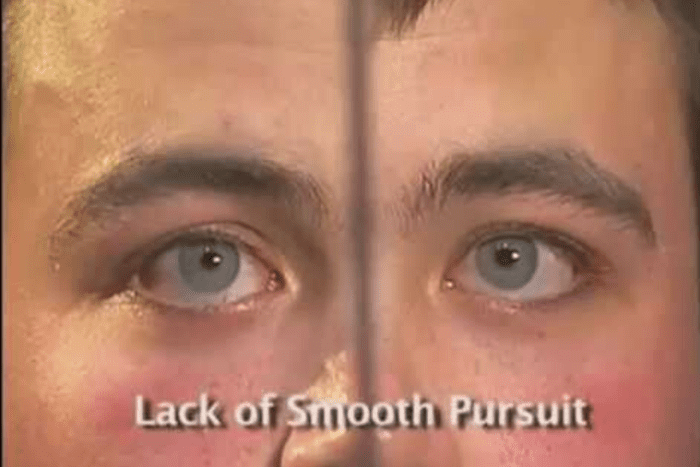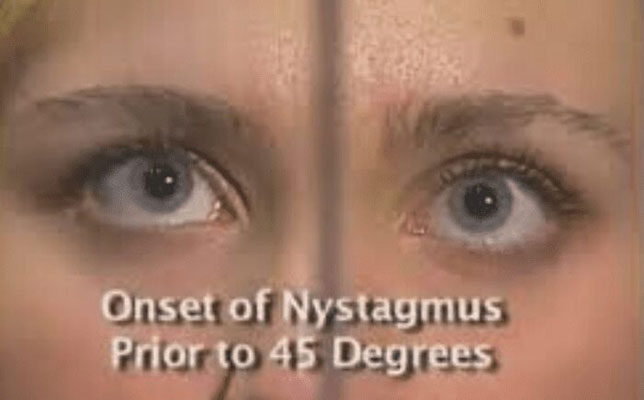If you’ve been pulled over for a DUI, and you’re in need of an Indianapolis DUI lawyer. call us at (317) 721-9858. When you are pulled over for the suspicion of DUI, the officer will initiate a number of field sobriety tests. The first of the three tests that can be used is the Horizontal Gaze Nystagmus Test. The HGN or Horizontal Gaze Nystagmus Test is a test for intoxication (as of a driver) based on observation of involuntary jerking eye movements as they follow horizontal motion.
What is a Field Sobriety Test?
Field sobriety tests are used to determine if an individual is intoxicated and thus under suspicion of a DUI or an OWI.
What is the Horizontal Gaze Nystagmus Test Procedure?
The officer will give you a set of instructions for the Horizontal Gaze Nystagmus Test when you are administered the field sobriety test. The HGN instructions include:
- If eyeglasses, have subject remove them
- Position stimulus approximately 12-15 inches from the subject’s nose.
- Position stimulus slightly above eye level
- The officer will say, “I am going to check your eyes.”
- The officer will say, “Keep your head still and follow this stimulus with your eyes only.”
- The officer will say, “Keep following the stimulus with your eyes until I tel you to stop.”
- The officer will say, “Check to see that both pupils are equal in size.”
- Did officer check for resting nystagmus at this time?
- Check for equal tracking
- ThCheck the suspects eyes for the ability to track together.”(no time given) 2 seconds minimum to perform
- Check subject’s left eye for smooth pursuit (as far to the side as it can go). (Repeat the procedure)
- Approximately2 seconds out and 2 seconds backCheck subject’s right eye for smooth pursuit (as far to the side as it can go). (Repeat the procedure) Approximately 2 seconds out and 2 seconds back
- Check subject’s left eye for smooth pursuit (as far to the side as it can go). (Repeat the procedure) Approximately 2 seconds out and 2 seconds back
- Check subject’s right eye for smooth pursuit (as far to the side as it can go). (Repeat the procedure) Approximately 2 seconds out and 2 seconds back
- Check subject’s left eye for distinct and sustained nystagmus at maximum deviation “observe eyes for distinct and sustained nystagmus. The officer will hold for a MINIMUM of 4 seconds
- Check subject’s right eye for distinct and sustained nystagmus at maximum deviation “observe eyes for distinct and sustained nystagmus. The officer will have you hold for a MINIMUM of 4 seconds
- Check subject’s left eye for distinct and sustained nystagmus at maximum deviation “observe eyes for distinct and sustained nystagmus. The officer will have you hold for a MINIMUM of 4 seconds
- Check subject’s right eye for distinct and sustained nystagmus at maximum deviation “observe eyes for distinct and sustained nystagmus. The officer will have you hold for a MINIMUM of 4 seconds

What are Horizontal Gaze Nystagmus Test Problems?
There are several problems with the Horizontal Gaze Nystagmus Test. Some of the problems with the Horizontal Gaze Nystagmus Test include:
- Nystagmus may be due to causes other than alcohol in three to four percent of the population
- Seizure medications
- Phencyclidine (PCP)
- Barbiturates
- Depressants
- Congenital disorder (birth defect)
- Sleep deprivation
- Acquired or central nervous system disorders
Horizontal Gaze Nystagmus Test
The Horizontal Gaze Nystagmus Test is effective only some of the time. As mentioned, there are several reasons as to why you may have failed the HGN section of a field sobriety test. If you have failed the HGN test and were arrested for DUI or OWI call Indianapolis criminal defense lawyer, Jesse K. Sanchez at (317) 721-9858 today.




